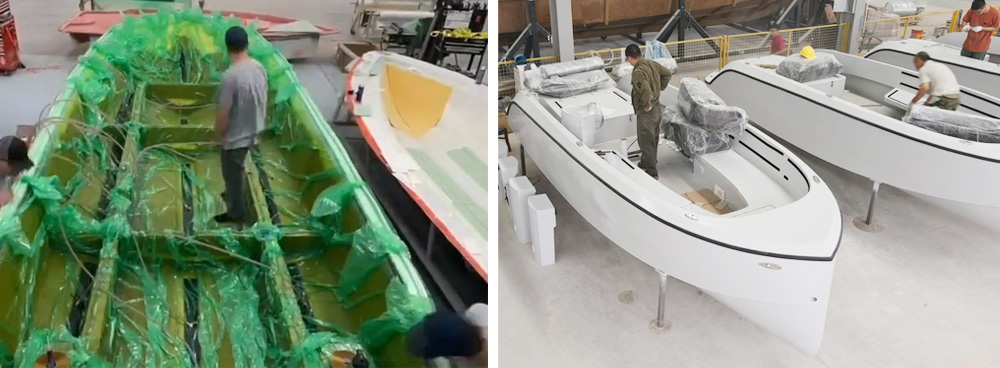Fiberglass reinforced plastic (FRP) boats have the advantages of light weight, high strength, corrosion resistance, anti-aging, etc. They are widely used in the fields of traveling, sightseeing, business activities and so on. The manufacturing process involves not only material science, but also fine process control to ensure the quality and performance of the final product.
Fiberglass reinforced plastic boat manufacturing process
(1) Mold transformation: The molds used in this project are all outsourced, and occasionally the molds need simple transformation.
(2) Mold cleaning: Clean the wax scale and dust on the surface of the mold. Clean gauze to clean all parts of the mold surface.
(3) Playing release agent: evenly rub the release agent on the mold surface to form a thin layer of smooth coating, wait 15 minutes for the next layer of coating, each mold shall be repeated 7 to 8 times.
(4) paint gel coat: paint gel coat in the mold, gel coat raw materials for gel coat resin, artificial use of brushes, bristle rollers to paint gel coat, first light and then deep uniform painting.
(5) Cutting: use scissors or blade to cut the fiberglass cloth to the appropriate length.
(6) Mixing and blending: use measuring cups to add curing agent to the unsaturated polyester resin and mix well, so that the resin condenses into a solid within a certain period of time, the curing process at room temperature without heating.
(7) Accumulation of layers: the accumulation of layers of the project process of hand gluing and vacuum in two ways.
Hand paste: after the gel coat solidifies to a certain degree, the resin will be blended and brushed on the gel coat layer, and then the pre-cut fiberglass cloth will be spread on the resin layer, and then the pressure roller squeezes the fiberglass cloth to make it uniformly impregnated with resin and discharge the air bubbles. After the first layer is completed and repaired, brush the resin and lay the fiberglass cloth again, and so on until the completion of the specified number of layers shall prevail.
Vacuum: lay the specified number of layers of fiberglass cloth on the interface of the mold, and lay the cloth layer of infusion cloth, infusion tube, paste the sealing tape, and then lay the vacuum bag membrane, install the vacuum valve, quick connector, vacuum tube, open the vacuum pump to use the negative pressure will be discharged from the air, and finally the use of negative pressure will be at room temperature will be deployed to inject the resin to the vacuum bag inside the natural conditions (room temperature) curing, curing, removal of the vacuum bag after the release of the mold. After curing, the vacuum bag is removed and demolded.
In the process of laying brush fiberglass and resin using roller brush, need to be cleaned in a timely manner, cleaning using acetone.
(8) laying reinforcement: according to the reinforcement needs, the core material cut into the required size and shape, and then accumulation process, when the FRP accumulation layer reaches the thickness of the design requirements, while the FRP resin is still gelling, quickly put on the core material, and as soon as possible with the appropriate pressure weight will be the core material of the flat in the FRP layer, to be the FRP curing, take off the weight, and then accumulate a layer of fiberglass cloth.
(9) rib gluing: FRP hull is mainly divided into upper and lower parts, need to use resin and fiberglass cloth in the lower part of the mold shaping out of the rib parts fixed on the hull, to facilitate the fixing and installation of the upper part of the hull. The principle of rib gluing is the same as that of ply.
(10) demolding: the laminate can be demolded after a certain time of curing, and the products are lifted out of the mold from both ends of the mold.
(11) Mold maintenance: maintain the mold for 1 day. Use a clean towel to rub off the release agent, waxing 2 times.
(12) Combining: Combine the top and bottom shells that have been cured and demolded, use structural adhesive to paste the top and bottom hulls together and assemble the mold.
(13) Cutting, sanding and drilling: the hulls need to be cut, partially sanded and drilled in order to assemble the hardware and stainless steel fittings later.
(14) Product assembly: the buckle, hinge, threading holes, drain, screws and other hardware and backrest, handle and other stainless steel fittings according to customer requirements using screws installed on the hull.
(15) Factory: the assembled yacht will leave the factory after passing the inspection.
Post time: Oct-08-2024







